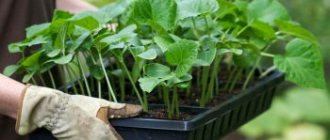The black beauty receives good reviews from gardeners because it combines several important consumer qualities - early ripening, high yield and delicate delicate taste. The plant itself is unpretentious and only requires timely implementation of some agrotechnical measures. A more detailed description of the variety and the rules for its cultivation can be found below.
Zucchini zucchini Black handsome
Black Beauty Zucchini Seeds
Zucchini bush Black handsome
Description of the variety
It was co-created by breeders S.V. Maksimov and N.N. Klimenko, and in 2006 it was included in the State Register of Breeding Achievements for cultivation in such regions as:
- Central Federal District (CFD);
- Central Black Earth Region;
- Northwestern Federal District (NWFD);
- Volgo-Vyatsky district.
In the first two areas, the variety is supposed to be grown in soil conditions, and in the last two – in greenhouse conditions.
The characteristics of the variety are given in the table:
| Parameter | Description |
| Ripening period | The variety is early ripening, which means that it will bear fruits suitable for harvesting within 45-55 days after the formation of the first shoots. |
| Features of the plant | This zucchini is a bush variety of squash and forms a compact leafy bush during the growing season. Let's look at its components separately:
|
| Features of the fruit | You should know the following information about Black Beauty:
The fruits have good keeping quality and can withstand transportation over long distances. |
| Application area | This zucchini has a universal purpose, so its fruits can be used for boiling, stewing, frying, pickling, canning, etc. Young zucchini measuring 10-15 cm have a delicious and delicate taste, so they can be used fresh, adding to vegetable salads as a substitute for cucumbers. |
| Productivity | Following the correct agricultural technology will allow you to get 9-10 kg of fruit from one bush. In terms of per unit area when planting according to the 60x60 cm scheme, the yield is about 20 kg per 1 sq. m. If the planting scheme is 60x100 cm, then from 1 sq. m you can collect up to 15 kg of fruit. The fruiting period lasts at least 3 weeks. During all this time, zucchini retains its high commercial qualities. |
| Disease resistance | Black beauty demonstrates high resistance to major diseases that pose a danger to plants of the Pumpkin family. These include powdery mildew and anthracnose. |
Description of zucchini variety Black Beauty
The authors of the zucchini variety Black Handsome: S. V. Maksimov and N. N. Klimenko. It was included in the State Register in 2006 and zoned in the Central and Central Black Earth regions for cultivation in open ground, as well as in the Northwestern and Volgo-Vyatka regions for cultivation in greenhouses.
Bush type plant. The bushes are densely leafy and compact. The leaves are green, with light spots, heavily dissected, medium in size.
The black beauty has been grown in Russia for more than 10 years
The fruits are dark green, without spots, shiny, smooth, with slight ribbing, cylindrical in shape. The average weight of the fruit is 0.8–1.7 kg, and the length is 20 cm. The peel is elastic and dense. The pulp is light, dense and juicy. The taste is delicate, very pleasant. These zucchini have universal uses in cooking: they are fried, stewed, stuffed, salted and pickled. Small fruits can be used fresh in salads.
The fruits of the Black Beauty zucchini reach 1.7 kg
Agricultural technology
Zucchini can only be planted in the garden after warm weather has settled. By this time, the temperature during the day should remain at +23°C, and at night it should not fall below 19°C. The soil should warm up to +10…+15°C.
As a rule, this regime is established from mid-May to early June. If the vegetable is planned to be grown under film, the sowing time can be moved forward - until the second ten days of April.
To extend the harvest period, sowing can be done in 4-5 stages with an interval of 5-6 days.
The method of cultivating vegetables depends on the climatic factor:
- In warm regions, seeds can be sown directly into open ground.
- In areas with a short summer season, it is better to choose the seedling method. In this case, seeds for seedlings should be sown in February or March. After 25-30 days, the seedlings will acquire several true leaves and will be suitable for planting in a permanent habitat.
Features of agricultural technology of zucchini squash
A rich harvest of vegetables depends not only on the properties of the variety. It is important to adhere to certain rules for caring for the Black Beauty, water and fertilize the plants in a timely manner.
Growing seedlings
Since this variety is considered an early variety, it is better to grow seedlings indoors and then transplant the plants into the garden bed. It is most convenient to use peat cups for seedlings. Individual containers will allow you to avoid damaging the delicate roots during transplantation. They should be filled with a mixture of peat and garden soil to a height of 8 cm. The soil should be watered with Fitosporin diluted in water, and the seed should be placed at a depth of 2-3 cm.
Sprouts need to be provided with eight hours of daylight and daily watering with settled water.
Sowing seeds in open ground
Summer residents from warm regions can sow seeds directly into open soil. The time for this stage should be selected taking into account weather and climatic conditions. The optimal period is considered to be from mid-April to the end of May, when the temperature does not drop below +15 degrees. You should choose a site where not Pumpkins, but root crops or legumes previously grew.
Advice!
Before planting, it is advisable to treat the seeds with a solution of potassium or sodium humate. After a few days, they can be sown in the soil, placing 2 pieces in a hole to a depth of 4 cm. The distance between the holes is 70-90 cm from each other.
Rules for caring for plants
Zucchini need care, which consists of watering, fertilizing, shaping and loosening. Each of the procedures affects the yield of vegetables to a greater or lesser extent.
In order for the plant root to have access to air and the soil to be well and evenly moistened, it is necessary to loosen the soil. This can be done with a small tool, but you should be careful not to touch the stems.
It is especially important to fluff up the soil after watering, as its surface may become hard.
It is necessary to pick the fruits in time, as this will provoke the appearance of new ovaries. If the plant has grown greatly, shades the fruits and moisture collects under it, several large leaves should be removed.
Watering and fertilizing
Zucchini contains up to 80% water, so the plants need frequent moisture. Once a week you need to water 5 liters of warm, settled water under each bush. Water should be poured near the stem itself so that drops do not fall on the leaves and the stream does not wash away the root.
Important!
During the period of flowering and fruit appearance, you need to double the frequency of watering.
At the same time, you should fertilize the bushes with organic matter or wood ash. To ensure rapid development of stems, you can add compost to the soil when planting seedlings or seeds. It is advisable to feed the plants with mineral fertilizers twice a season.
Harvest and storage
It is best to remove the fruits as soon as they reach a length of 20 cm. This will allow the bush to use strength and nutrients to form new ovaries. Also, young zucchini have a pleasant and delicate taste without a bitter tint. For salads made from fresh vegetables, 10-centimeter milk squash are suitable.
The Black Beauty variety has a thin but flexible peel that does not become scratched or stained during transportation.
If you store the fruit in a cool, dark place, you can extend the freshness of zucchini for several months.
Site selection and soil preparation
Black beauty should be cultivated in areas protected from winds and drafts, which are illuminated by sunlight for 8-12 hours. Its favorable predecessors are:
- legumes (better than other crops, they enrich the soil with nitrogen compounds necessary for squash);
- potato;
- cabbage (white, cauliflower);
- onion;
- garlic.
Zucchini cannot be grown after cucumbers, squash and other pumpkin crops. They can be returned to their original place only after 3-4 years.
When choosing a suitable site, you should also take into account the factor of a favorable neighborhood. It is best to place beans, green crops or radishes next to the squash bed, as they suppress the activity of weeds. Near them you can also place nasturtiums, marigolds or fragrant herbs (thyme, basil) - all of them repel potential pests and at the same time attract pollinating insects.
The soil should be light and fertile. A good option is loams and chernozems with neutral acidity. If the soil on the site is heavy and contains a lot of clay, sand should be added to the planting holes to improve its mechanical composition.
The selected area must be prepared for planting zucchini. For these purposes, starting in the fall, it is worth adding organic matter (manure, chicken droppings or humus) to it and digging it with a shovel. In cold regions, zucchini can be grown on a compost heap or warm bed, which is prepared in the following sequence:
- Place any organic debris in the ground:
- half-rotted manure;
- fallen leaves;
- straw;
- sawdust;
- tops (tomato, cucumber, beet);
- food waste.
- Lightly compact the bed and cover it with a layer of soil. Before sowing, dig it up, remove all plant debris, level it and dig holes.
In such a bed, a heat-loving zucchini will quickly grow and bear fruit, constantly receiving heat and carbon dioxide from rotting organic matter.
A similar “slide” can be prepared in the spring, but the procedure will be slightly different. Initially, you will need to dig small trenches in the ground (about the size of a shovel), and then put all the organic matter in them and cover them with soil. In such a bed you need to dig holes into which you add a handful of humus and wood ash. The composition should be watered well with hot water, and then the seeds or seedlings should be planted.
Characteristic differences
Unlike classic zucchini, “black beauty” zucchini tastes more like a pumpkin than its “brothers.” In some countries, all types of zucchini are called zucchini. And yet, green fruits have their own distinctive characteristics.
- They are famous for their delicate pulp and skin, which cannot be said about light-colored zucchini.
- Zucchini can be eaten fresh. Nutritious salads are prepared from them without heat treatment.
- Zucchini "black beauty" is noted as one of the highest-yielding varieties.
- Since the crop develops in the form of a bush, it is more convenient to care for it and there is no need to allocate a large area for planting it.
- The bush culture is capable of setting 5 fruits at a time.
- The variety is resistant to powdery mildew and other fungal diseases.
Pre-sowing seed treatment
In order for the seeds to germinate quickly and simultaneously, they must be subjected to pre-sowing treatment. It consists of carrying out the following manipulations:
- Check all seeds visually and by touch, removing hollow specimens (they will not provide entry).
- To disinfect, soak the seeds for 20 minutes in a pink solution of potassium permanganate, and then rinse with clean water.
- For rapid germination, keep the seeds in a growth stimulator or potassium/sodium humate for 24 hours (1 tsp per 1 liter of warm water).
- For the seeds to hatch, wrap them in a damp cloth and keep them in a warm place for 2-3 days. During this time, you need to keep the fabric moist.
Seeds with sprouts are suitable for planting in warm soil.
Care
Zucchini must be watered
The black beauty loves moisture; to water the zucchini you need warm water: pour liquid under the root, but be careful so that the thin stem does not break.
Avoid getting moisture on the leaves, especially in hot weather.
During the flowering period, use 5-6 water per crop. Irrigation work is carried out no more than once a week. After this, watering is carried out twice a week.
If a sufficient amount of organic matter was added during planting, the zucchini does not need feeding. Additional strengthening will be provided by a homemade decoction of nettles, which is used to water the bush. Weeds are removed around the crop.
Seedless growing method
The hatched seeds are sown in warm, loose soil, taking into account the following recommendations:
- The optimal planting pattern is 60x60 cm, but the intervals between holes can be reduced to 35-40 cm if there are concerns that not all seeds will sprout. If a vegetable is planted in several rows, then about 1 m can be maintained between them, otherwise vigorous bushes will not have enough free space for full development.
- Bury the seeds 5-7 cm, but in the case of heavy soils, the optimal planting depth is 3-5 cm.
- Place 2-3 seeds in each hole. If after a week several shoots appear, then you will need to leave the strongest sprout, and remove the rest (pinch it above ground level, and not pull it out, so as not to damage the entire root system of the plant).
After planting, moist soil should be mulched with humus or compost to retain moisture and prevent the development of weeds.
Landing
Black Beauty squashes love enriched and structured soils. Their seeds are sown both as seedlings and directly into the ground.
The seedling method promises the gardener additional care for the plant, because zucchini does not tolerate transplantation well. On the other hand, it speeds up the process of the appearance of the first fruits, subject to proper care. Seedlings should be planted when 2-3 true leaves appear.
Since all pumpkin crops are unpretentious, the seed sowing method is considered more convenient. If you pre-soak the seeds, you can significantly speed up their germination. The seeding depth is 4 cm. It is important to take weather conditions into account. Zucchini is a heat-loving plant, and at low temperatures the seeds can rot in the ground.
Experienced farmers sow zucchini seeds in places where legumes, nightshades and root crops previously grew. Where any plants from the pumpkin family previously grew, zucchini cannot be planted.
The distance between the rows is 70-80 cm. It is better to place the plants in a checkerboard pattern. The optimal distance with this method is 60 cm.
Planting zucchini through seedlings
About a month before transplanting the seedlings into open ground, you need to sow the seeds in separate plastic or peat cups 10-15 cm high, since the vegetable crop does not tolerate picking well. Seedlings are grown in the following sequence:
- Fill the cups 1/2 full with the nutritional composition. If in the future the plant becomes very elongated, then thanks to the free space left, the stem can be carefully twisted in the pot and sprinkled with soil up to the cotyledon leaves. The soil composition itself can be bought at a garden store or prepared with your own hands by mixing nutrient soil with leaf humus. It is advisable to add a handful of wood ash, urea or ammonium nitrate and other mineral fertilizers to it. The resulting mixture must be disinfected by watering it with Fitosporin solution.
- Place 2 grains into slightly moistened soil to a depth of 3 cm, always with the root root facing down. If in the future all the seeds sprout, then only the strongest shoots should be left.
- Place the pots with seeds in a warm and bright room until the first shoots appear. Moisten the soil at least once a week to prevent it from drying out.
- 7-10 days before planting, start hardening the seedlings, taking them out into the fresh air for 2-3 hours every day. Gradually, this period of time needs to be increased so that in the end the plant spends the whole day outside.
Seedlings with 2-3 leaves should be transplanted into the garden bed early in the morning or on a cloudy day to minimize stress on the plant. The holes need to be prepared at a distance of 60-70 cm. It is better to maintain 80-90 cm between the rows.
You can add humus, compost, ash, rotted sawdust or peat to each hole at the rate of a bucket of nutrient mixture for each plant. You need to make a hole in the resulting mixture, plant the seedlings together with a lump of earth, sprinkle soil up to the cotyledon leaves, water with warm water and tamp lightly.
If there is a risk of frost returning, in the first days the planting should be kept under film and regularly ventilated. If the seedlings were planted on very sunny days, so that the seedlings do not burn under the scorching rays, they should be shaded using agrofibre or a large cut plastic bottle. When the plant gets stronger and begins to grow actively, the shelter must be removed.
Features of planting zucchini
Zucchini Black Beauty is grown in seedlings and without seedlings. Preparing seeds for sowing includes the processes of selection, soaking, germination, disinfection and growth stimulation.
Stages of preparing seeds for sowing
- Selection. Sort through the zucchini seeds, immediately discarding empty, small and damaged ones.
- Disinfection. Soak the seed material in a 1% solution of potassium permanganate (potassium permanganate) for about 20 minutes, then rinse.
Before sowing, zucchini seeds are disinfected in a solution of potassium permanganate.
- Soak. To stimulate growth, you can soak the seeds in ordinary melt water or in a solution of one of the biostimulants (sodium humate, Epin, Zircon, etc.).
- Germination. Spread the zucchini seeds in a thin layer on a damp cloth and cover with film. Maintain a temperature of 20–25 °C until sprouts appear. Plant the sprouted seeds in cups or prepared soil.
Site preparation
Zucchini prefers chernozem and light loamy soil with deep surface water. A sunny site is selected, but taking into account crop rotation. Zucchini is planted in regular or insulated beds. Recently, summer residents have begun to more often use warm mini-beds, which look beautiful and are easy to care for. The first harvest of zucchini can be obtained much earlier than in the garden.
It is very easy to care for zucchini planted in a warm bed.
Preparation is carried out in several stages:
- First, the soil is enriched with mineral fertilizers and organic matter. Add 3 kg of rotted manure or compost soil, 50 g of wood ash, 30 g of nitroammophosphate per 1 m2 of area.
- After this, the bed is dug up.
- Then the soil is spilled with a solution of universal fertilizer at the rate of 3 liters per square meter of area.
Most often, a special mineral complex Agricola-5 is used on squash beds (dry granules are dissolved in water at the rate of 1 tablespoon per 10 liters). You can also use analogues of this fertilizer - preparations Rossa, Effecton, etc.
Basic landing rules
- Under no circumstances should the predecessors of zucchini be pumpkin crops.
- Zucchini can be planted in open ground if the soil has warmed to a temperature of 13–14 °C and the air temperature has reached 20 °C.
- Germinated seeds are sown only in moist soil.
Video: secrets of growing zucchini in a warm garden bed
Planting seedlings in open ground
Seeds for seedlings are sown in April or May, depending on the region. It is recommended to grow zucchini in cups so as not to damage the root system of the seedlings when planting. After about a month, seedlings in the phase of 3–4 true leaves are planted in open ground. Zucchini takes up less space than regular zucchini, and their vines do not spread over the entire area. With the seedling method of planting, a distance of 70 cm between holes and 80 cm between rows is sufficient.
Zucchini grown in seedlings will provide you with an earlier and higher harvest
The plants, together with the earthen lump, are carefully taken out of the container and deepened 5–6 cm into the soil, after first spilling the holes with water. If seedlings are planted in peat pots, then their edges are left a few centimeters above the soil level.
To make zucchini take root in open ground faster, experienced gardeners do the following:
- The top of the hole is sprinkled with dry soil and, if possible, mulched with peat to avoid the formation of an earthen crust.
- Plants are planted in cloudy weather or in the evening. This way you can protect tender young shoots from sunburn.
- To protect large areas of plantings from frost, covering material is used.
The squash bed is protected from frost with covering material
If there are few seedlings, they can be covered with plastic bottles. To do this, the lower part is cut off, and the top with a lid is used as a shelter. Plastic bottles are convenient because the cap can be easily removed for ventilation. When the plants adapt to new growth conditions and a stable daytime air temperature of 22–25 ° C is established, the shelter is removed.
Sowing seeds in the garden
Zucchini is a heat-loving plant, so seeds begin to be sown in stable warm weather, when there is no longer any fear of return frosts. Sowing zucchini in open ground in different climatic zones occurs from the beginning of May to the end of July.
Prepared seeds are sown in 2 pieces. into each hole to a depth of 3–4 cm according to a 60x60 cm pattern. The sowing sites are covered in the same way as with the seedling method. After germination, the weaker sprout is removed by cutting it off at the base carefully with a knife so as not to damage the neighboring plant. After a month, these seedlings can no longer be distinguished from grown seedlings.
Covering zucchini crops with plastic bottles helps speed up seedling growth
To keep your favorite vegetable longer, you can sow it in several stages with an interval of seven days.
Caring for Black Beauty
It consists of carrying out several simple manipulations in a timely manner.
Watering
Zucchini needs a lot of moisture, since they themselves are 90% water. However, you should not overdo it with watering, so as not to expose the root system of the plant. The optimal watering scheme is as follows:
- Before the flowering period begins . To prevent the formation of a crust on the top layer of soil, it is enough to water the plant once a week at the rate of 5 liters of water per bush or 5-6 liters per 1 square meter. m.
- During flowering . Increase the frequency of watering to 3-4 times a week, and the water consumption to 8-9 liters per 1 sq. m.
- During the period of fruiting (formation of fruits) . Water at least 2 times a week, pouring at least 10 liters of water under each bush.
On dry days, the squash bed should be watered once every 2 days.
When watering, you should use only warm water, as cold water will cause rotting of the ovaries and fruits. It should be poured directly under the root, avoiding any droplets getting on the tops.
Loosening
The roots of a vegetable crop are located close to the surface of the earth, so some gardeners do not loosen the soil around the bushes. In this case, it is extremely important to prepare the bed in advance - before sowing, loosen it and remove all weed residues.
If the soil was poorly prepared, then a few hours after watering it can be lightly loosened. There will be no need for this procedure if you plant greens, radishes or beans next to the squash bed. Such plantings prevent the growth of weeds, and by the time full-fledged bushes are formed, the zucchini will have already completed its fruiting and will be suitable for harvesting.
Formation
Black beauty is not a climbing variety of zucchini and does not particularly require shaping. However, its bushes grow strongly, and the large lower leaves shade the fruits on the central stem and interfere with pollinating insects. To prevent this from interfering with the abundant flowering of the plant, you need to regularly remove the lower yellowing leaves, but no more than 3 at a time. Barren flowers - flowers without ovaries - are also subject to removal.
Top dressing
The plant constantly blooms and bears fruit, spending too much energy on this process. To maintain the viability of the plant, it should be fed 3 times during the entire growing season:
- Before the flowering phase . Add an infusion of bird droppings or mullein (0.5 liters of organic matter per 10 liters of water) under the bush at the rate of 2 liters per 1 plant. An alternative option is a solution of nitroammophoska (20-30 g per 10 liters of water).
- During the flowering period . Fertilizing is carried out with a potassium-phosphorus mixture. To prepare it, you need to mix 50 g of potassium nitrate and superphosphate, and then dilute it in 10 liters of water. Fertilizer consumption - 1 liter for each bush. The plant can also be fed with potassium humate.
- At the stage of ovary formation . As a final fertilizing, you need to add organic fertilizer with an infusion of wood ash.
Zucchini should not be fed with products that contain chlorine.
Additional feeding can be abandoned only if a sufficient amount of the nutrient mixture is added when planting the crop. In this case, the squash bushes can be watered with infusion of nettles or other weeds. It is prepared in the following order:
- Fill the pan with weeded weeds to 3/4 of its volume and fill with water to the level that there is room for fermentation. Otherwise, during the decomposition process, the liquid will overflow over its edge.
- Cover the pan with film and tie it so that oxygen does not enter it, and nitrogen does not evaporate from it.
- Leave the composition for about 2 weeks. This time will be enough for the fermentation processes to complete and the composition to acquire the characteristic smell of a stable.
The finished composition must be diluted with water 1:2 for root feeding and 1:5 for foliar feeding. Use together with watering.
An infusion of weeds will not only be an excellent fertilizer for zucchini, but also protect the crop from potential pests (it scares them away with its pungent smell).
Pollination
If not enough ovaries are formed on the bushes, you need to attract even more insects for pollination. To do this, the plant must be sprayed with sugar syrup or sweet water.
Protection from diseases
For prevention purposes, you must adhere to the following rules for growing zucchini:
- observe crop rotation and do not plant vegetables in the same place for 2 years in a row;
- do not flood the bushes with water, creating a favorable environment for the development of pathogenic microflora;
- Before planting, the seeds must be disinfected;
- follow the above planting patterns and do not thicken the planting;
- At the first signs of the disease, remove the affected parts of the plants or entire bushes (they need to be taken outside the site and burned), and the rest of the planting should be treated with chemicals.
Rules of care when growing Black Beauty
Zucchini Skvorushka
At the beginning of the growing season, it is necessary to provide the plants with timely watering, since a lack of moisture can lead to the death of young seedlings. Zucchini should be watered with warm water at a distance of 20 cm from the root to eliminate the possibility of root rot.
When weeds appear, they should be removed and the soil at the base of the plants should be loosened. This will help improve aeration and ensure full development of the root system.
During the formation of buds and ovaries, fertilize with potassium and phosphorus fertilizers or use wood ash.
Feeding zucchini
In the phase of formation of the 5th leaf, each plant should be hilled, which stimulates the growth of additional roots and will further strengthen the bushes.
As the bushes grow, it is necessary to mulch the soil around them, which will prevent excessive evaporation of moisture and prevent the growth of weeds. Straw, humus or peat should be used as mulch.
To improve fruit set, foliar spraying with boric acid should be carried out during the flowering period.
Boric acid for spraying
Important! You cannot plant Black Beauty zucchini after pumpkin, squash and cucumbers, as these crops are susceptible to the same diseases. The best option is to sow after potatoes, legumes, onions, and cabbage.
Fruit harvesting should be carried out at least 2-3 times a week, as this promotes the formation of new buds and ovaries. For further storage of zucchini, a cool, dry room is necessary; only in this case can the harvest be preserved for 2 months without loss of beneficial properties.
Fruits from the bush should be cut at an acute angle at a distance of 4-5 cm from the base, since twisting and manual harvesting can damage the entire bush.
Zucchini fruits Black handsome
Harvest and storage
The harvest period is July-August. Zucchini measuring 15-20 cm should be cut with a stalk no less than 5-10 cm long. To stimulate the development of new ovaries, fruits should be picked every 2-3 days, preventing them from overripening. Immediately after harvesting, it is recommended to water the bush abundantly.
For long-term storage, you should select fruits weighing about 1 kg, which were collected before the onset of frost. The soil from them should be wiped off with a dry cloth, and not washed off with water. They need to be stored open and not in plastic bags, otherwise the condensation that forms will contribute to their rotting. It is advisable to sprinkle sawdust or lay out scraps of newsprint between the zucchini.
Zucchini should be stored in a dry, cool and dark place at a temperature of +4...+10°C. This could be a basement, cellar or storage room. They can be kept in this place for up to 2 months.
Pros and cons of the variety
Strengths of Black Beauty:
- has an early ripening period;
- has excellent appearance and taste (thin skin and tender, juicy, dense pulp);
- grows in the form of a compact bush, but has a high yield - up to 20 kg of fruits per 1 sq. m;
- bears fruit for a long time;
- bears fruits of universal use, which have good shelf life (about 2 months) and transportability.
This variety has no obvious disadvantages, but some gardeners note that it is heat-loving and sensitive to cold snaps. The fruits themselves spoil quickly at room temperature, so they need to be kept either in the refrigerator or in the cellar.
general characteristics
According to the description, Black Beauty is a bush type zucchini, this zucchini is suitable for growing in open ground or in greenhouse conditions.
Zucchini is popularly called green squash because of the characteristic color of the fruit, but they are only a variety of it.
Differences from standard varieties:
- bush shape - they are smaller in size;
- increased productivity;
- faster ripening time (can be harvested by mid-to-late summer).
Feature of the variety
Black Beauty is an early variety; it ripens by mid-summer: the average ripening period for zucchini is 55 days.
Productivity is high: from 5 to 9 kg/m2. One ovary on a bush produces up to 5 fruits.
Advantages of the variety:
- Long-lasting harvest - ensures early ripening and rapid formation of ovaries, while the yield is stable even under unfavorable environmental conditions;
- Unusual appearance: black fruits, bushes have a lot of foliage, which acts as a shelter for the fruits in summer.
- Compact vines do not require much free space in the garden. The vegetable has bright green leaves, moderately thick lashes and massive bright orange inflorescences.
- The variety is resistant to most garden diseases. It is not afraid of powdery mildew, mold, or rot.
There are few disadvantages. Zucchini is characterized by medium keeping quality. It may suffer due to improper care or severe drought in the warm season.
Appearance
The early-ripening variety Krasavchik bears fruit consistently – the fruits ripen at the same time.
The fruits are the same in shape and size: elongated, smooth (there is a slight ribbing, but it is barely noticeable. The color is dark green, almost black - hence the name zucchini.
The skin is uniform without spots, evenly smooth and shiny. It may have stripes that appear during the ripening period.
The weight of one fruit is from 1 to 1.5 kg. Record holders weigh up to 2 kg. Average length 20-22 cm.
Zucchini tastes sweetish, emits a pleasant aroma, and can be consumed immediately after harvesting.
Reviews of Black Handsome
★★★★★
Elena Antonovna, 41 years old. I grew Black Beauty zucchini on my plot this year.
I can note excellent germination and productivity. The fruits are very tasty and have a small seed part. By the way, their color turned out to be not as black as the manufacturer expected. This may be due to the fact that I grew the plant in a sunny bed. ★★★★★
Igor Petrovich, 53 years old. This is one of the most favorite varieties of zucchini.
The plant is unpretentious and very productive - it is simply strewn with flowers and ovaries. This year, one part of the collected fruits was consumed for food within a few weeks, and the rest was used to prepare food for the winter. ★★★★★
Angelina Vladimirovna, 55 years old. I grew Black Beauty zucchini this year for the first time.
The plant did not require any special care - weed it only 2 times, watered it and removed the lower leaves several times. The bushes blossomed and bore fruit well. The zucchini formed quickly, I barely had time to remove them. Hide
Add your review
A short review is given in the video below:
Black Beauty is an early-ripening zucchini variety that bears smooth, almost black fruits up to 25 cm long and weighing up to 1 kg. The plant itself is compact in size and not particularly whimsical - even an inexperienced gardener can grow it in his or her garden.
0
0
Copy link
Description
This pumpkin variety is classified as zucchini. It is characterized by a dark green color and a glossy surface. By the way, the color may vary slightly. It depends on the conditions in which the “black beauty” zucchini was placed. This includes its location in the garden plot, feeding, and climatic conditions in which it finds itself. It has been noticed that even on one bush the fruits come in different shades. The size of the fruit is about 20 cm. The compact bush throws out long cuttings, with beautiful carved leaves, in white streaks.











